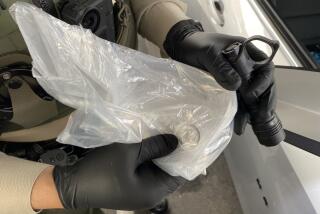A High-Tech Nose for Crime
IRVINE — When 17-year-old Earl Rhoney walked out of Orange County Juvenile Hall on Oct. 21, 1994, after serving time for burglary and weapons charges, a bloodhound and a strange little machine waited in the shadows.
The machine, a tiny vacuum that collects scent onto a gauze pad, had been used on the sweater of a woman who had been bludgeoned and strangled in her Irvine home. Inside, police believed, it stored the killer’s scent.
As Rhoney walked across the street from Juvenile Hall to the City Shopping Center in Orange, police removed a gauze pad and gave it to Duchess, an 8-year-old bloodhound, to sniff. Within minutes, Duchess followed Rhoney’s trail and picked him out of a crowd in the mall as he stopped to make a phone call.
Last week, Rhoney was found guilty of murder, the first time in California that the machine, called a Scent Tracker Unit 100, was used to help convict a murder suspect.
“There were probably a few hundred directions the dog could have traveled in, but she chose this one to track,” said Irvine Police Investigator Larry Montgomery, who displayed the Scent Tracker on Monday.
The Scent Tracker allows police to preserve scents from evidence such as clothing, carpet or furniture that otherwise might be contaminated when it is removed from the crime scene or treated with chemicals in crime labs, police said.
Rhoney had become a suspect in the Jan. 20, 1994, murder of Patricia Lea Pratt, 45, when he was arrested on suspicion of burglarizing a home in her Turtlerock neighborhood two weeks after the slaying. But police had no physical evidence to link Rhoney, who also lived in Turtlerock, to the slaying, Montgomery said.
Police used the machine on her clothing and froze the pad for nine months, until the moment that it was removed from a bag and given to Duchess.
The forewoman in Rhoney’s trial said jurors believed that the machine could effectively move scent from one object to another. Jurors also convicted Rhoney because they believed that carpet fibers gathered from his shoes and belt matched the carpet in the victim’s home.
In a jailhouse interview Friday, Rhoney maintained his innocence and said he plans to challenge his conviction. Deputy Public Defender Sharon Petrosino said she plans to seek a new trial on the basis that evidence from the Scent Tracker should not have been admitted.
Although evidence obtained from the machine has not been challenged, it has been upheld in New York, where it was first used several years ago, said Deputy Dist. Atty. Debbie Lloyd, who prosecuted Rhoney.
More to Read
Sign up for Essential California
The most important California stories and recommendations in your inbox every morning.
You may occasionally receive promotional content from the Los Angeles Times.









